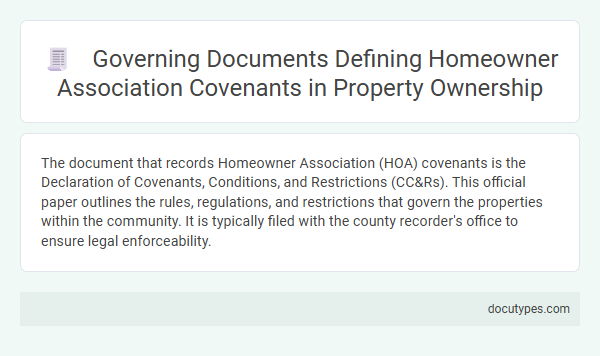The document that records Homeowner Association (HOA) covenants is the Declaration of Covenants, Conditions, and Restrictions (CC&Rs). This official paper outlines the rules, regulations, and restrictions that govern the properties within the community. It is typically filed with the county recorder's office to ensure legal enforceability.
Introduction to Homeowner Association Governing Documents
Homeowner Association (HOA) covenants are legally binding rules that govern property use within a community. These covenants are documented in specific governing documents that outline the rights and responsibilities of homeowners.
- Declaration of Covenants, Conditions, and Restrictions (CC&Rs) - This primary document records the HOA covenants and restrictions binding all homeowners in the community.
- Bylaws - These documents establish the HOA's organizational structure and procedures for enforcing the covenants.
- Rules and Regulations - These are additional guidelines adopted by the HOA board to provide detailed governance beyond the covenants.
Purpose and Importance of HOA Covenants
Homeowner Association (HOA) covenants are recorded in the Declaration of Covenants, Conditions, and Restrictions (CC&Rs). This document legally outlines the rules and guidelines that govern a residential community.
The purpose of HOA covenants is to maintain property values and ensure a uniform appearance throughout the neighborhood. These rules help protect your investment by regulating property use, architectural standards, and community behavior. Understanding the importance of these covenants allows you to comply with community standards and avoid conflicts or penalties.
Key Types of Governing Documents in Property Ownership
Homeowner Association (HOA) covenants are primarily recorded in the Declaration of Covenants, Conditions, and Restrictions (CC&Rs), which outlines the rules and obligations for property owners within the community. Other key governing documents include the bylaws, which manage the operation of the HOA, and the articles of incorporation that establish the association as a legal entity. You can find these documents recorded with the county recorder's office, making them essential for understanding community regulations and property rights.
Declaration of Covenants, Conditions, and Restrictions (CC&Rs)
The Declaration of Covenants, Conditions, and Restrictions (CC&Rs) is the primary document that records Homeowner Association (HOA) covenants. This legal document outlines the rules, restrictions, and obligations binding homeowners within the community. CC&Rs govern property use, maintenance requirements, and architectural guidelines to preserve neighborhood standards.
Bylaws: Structure and Operations of the Association
Bylaws serve as the primary document recording the homeowner association covenants, detailing the structure and operations of the association. These bylaws establish the framework for governance, including the roles of the board of directors and the procedures for meetings.
Your obligations as a homeowner are outlined within these bylaws, ensuring clarity on voting rights, assessments, and maintenance responsibilities. Understanding these provisions helps maintain community standards and enforces compliance among members.
Rules and Regulations: Enforcement and Compliance
| Document Name | Declaration of Covenants, Conditions, and Restrictions (CC&Rs) |
|---|---|
| Purpose | Establishes the rules and regulations governing the community's properties and outlines the responsibilities of homeowners and the Homeowner Association (HOA). |
| Content Focus | Details specific covenants and restrictions, architectural guidelines, property use, maintenance obligations, and behavioral standards to maintain community standards. |
| Enforcement Authority | The HOA Board, empowered by the CC&Rs, enforces compliance through fines, warnings, or legal action to ensure community standards are upheld. |
| Compliance Requirements | Homeowners must adhere to the CC&Rs and any additional rules adopted by the HOA, such as noise regulations, landscaping standards, and property alterations. |
| Role of Rules and Regulations | Supplement the CC&Rs by providing detailed operational guidelines and procedures for enforcement, ensuring consistent application of the covenants. |
| Your Responsibility | You are required to review and comply with these documents to avoid violations and potential enforcement actions from the HOA. |
Architectural Guidelines and Standards
The document that records Homeowner Association covenants is typically the Declaration of Covenants, Conditions, and Restrictions (CC&Rs). Architectural guidelines and standards are detailed within these covenants to ensure uniformity and maintain property values.
- Declaration of Covenants, Conditions, and Restrictions (CC&Rs) - This legal document outlines the homeowners' rights and responsibilities, including architectural controls.
- Architectural Guidelines - These guidelines specify design, materials, and construction standards for exterior home modifications.
- Standards Enforcement - The HOA uses these documented standards to approve or deny architectural change requests, preserving community aesthetics.
Amendment Procedures for HOA Documents
Homeowner Association covenants are officially recorded in the Declaration of Covenants, Conditions, and Restrictions (CC&Rs). These documents establish the rules and guidelines that govern the community's properties.
Amendment procedures for HOA documents typically require approval from a majority or supermajority of homeowners. You must follow specific steps outlined in the CC&Rs, which often include written notice, a formal vote, and recording the changes with the county.
Legal Implications of Violating HOA Covenants
The document that records Homeowner Association (HOA) covenants is typically the Declaration of Covenants, Conditions, and Restrictions (CC&Rs). This legal instrument outlines the rules and standards homeowners must adhere to within the community.
- Enforcement Authority - The HOA has the legal power to enforce CC&R violations through fines, liens, or legal action.
- Property Value Impact - Violating HOA covenants can negatively affect your property value and community reputation.
- Legal Consequences - Persistent non-compliance may lead to court orders, forced compliance, or even foreclosure in severe cases.
Understanding and adhering to the CC&Rs is essential to avoid legal and financial repercussions within your HOA community.
Which Document Records Homeowner Association Covenants? Infographic

